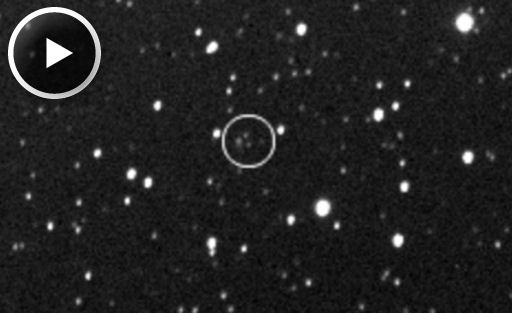TROUBLE CONTACTING MARS: NASA is suspending communications with Mars rovers and orbiters this month as the Red Planet passes almost directly behind the sun. Mars is less than 2o from the sun now, and the distance will narrow to a mere 0.4o on April 17th. "The sun can easily disrupt radio transmissions during the near-alignment," explains a NASA press release.
FAST-GROWING SUNSPOT: Solar activity is low, but a fast-growing sunspot could break the spell of quiet. AR1718 has more than doubled in size during the past 48 hours as shown in this movie from the Solar Dynamics Observatory:
The magnetic field of AR1718 is rapidly changing and therefore prone to instabilities. If it criss-crosses and reconnects--bang! A solar flare could occur. Because of the sunspot's central location on the solar disk, any eruptions would be Earth-directed. NOAA forecasters estimate a 20% chance of M-class flares on April 9th. Solar flare alerts: text, voice.
Realtime Space Weather Photo Gallery
COMET ISON UPDATE: In November 2013, Comet ISON could become one of the brightest and most active comets in years when it races through the hot atmosphere of the sun. Right now, though, it is just a dim speck in the deep-freeze of space near the orbit of Jupiter. Alberto Quijano Vodniza photographed the barely-visible comet on April 7th from his private observatory in Pasto, Narino, Colombia:
Comet ISON may look underwhelming, but that is only because it is so far away, more than 400 million miles from the sun. In fact, it is already an active comet with considerable promise. Recent measurements by NASA's Swift spacecraft shows that the comet's nucleus is spewing more than 112,000 pounds (51,000 kg) of dust, or about two-thirds the mass of an unfueled space shuttle, every minute. To produce so much dust, the comet's nucleus is probably about 5 km wide. For comparison, the nucleus of bright sungrazing Comet Lovejoy, which wowed observers in 2011, was only about one-tenth as large. Comet ISON could put on quite a show when it approaches the sun later this year.
More about Comet ISON: NASA video, 3D orbit, ephemeris, light curves.

![]()
Solar wind
speed: 341.6 km/sec
density: 3.0 protons/cm3
explanation | more data
Updated: Today at 0137 UT
![]()
X-ray Solar Flares
6-hr max: C1 2003 UT Apr09
24-hr: C2 0724 UT Apr09
explanation | more data
Updated: Today at: 2359 UT
![]()
![]()
![]()
Daily Sun: 09 Apr 13
![]()
![]()
Sunspot AR1718 is growing rapidly and could pose a threat for Earth-directed M-class solar flares. Credit: SDO/HMI
![]()
![]()
![]()
Sunspot number: 162
What is the sunspot number?
Updated 09 Apr 2013
Spotless Days
Current Stretch: 0 days
2013 total: 0 days (0%)
2012 total: 0 days (0%)
2011 total: 2 days (<1%)
2010 total: 51 days (14%)
2009 total: 260 days (71%)
Since 2004: 821 days
Typical Solar Min: 486 days
Update 09 Apr 2013
The Radio Sun
10.7 cm flux: 139 sfu
explanation | more data
Updated 09 Apr 2013
![]()
![]()
![]()
Current Auroral Oval:
![]()
Switch to: Europe, USA, New Zealand, Antarctica
Credit: NOAA/POES
![]()
![]()
![]()
Planetary K-index
Now: Kp= 1 quiet
24-hr max: Kp= 2 quiet
explanation | more data
![]()
Interplanetary Mag. Field
Btotal: 5.4 nT
Bz: 2.8 nT north
explanation | more data
Updated: Today at 0137 UT
![]()
![]()
![]()
Coronal Holes: 09 Apr 13
![]()
![]()
Solar wind flowing from this sinuous coronal hole could reach Earth on April 11-12. Credit: SDO/AIA.






